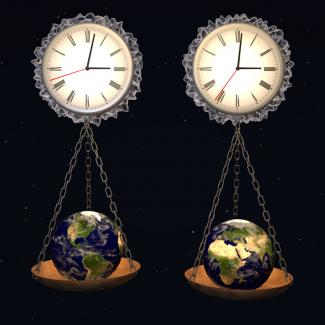The Ye group has just improved the accuracy of the world’s best optical atomic clock by another factor of three and set a new record for clock stability. The accuracy and stability of the improved strontium lattice optical clocks is now about 2 x 10-18, or the equivalent of not varying from perfect time by more than one second in 15 billion years—more than the age of the Universe. Clocks like the Ye Group optical lattice clocks are now so exquisitely precise that they may have outpaced traditional applications for timekeeping such as navigation (GPS) and communications.
However, the new clocks promise to be excellent precision measurement tools for measuring Earth tides, improving our understanding of the basic shape of the Earth (geodesy), conducting tests of the fundamental laws that govern space and time, gaining a deeper understanding the quantum world, and providing a novel pathway for investigating unknown phenomena such as dark matter.
On the flip side, the Ye group may have rendered impractical (for now) the concept of measuring and coordinating absolute time with such a super-accurate clock. The Ye group’s accomplishments mean the global timekeepers will have to pioneer new ways to distribute such precise time and synchronize clocks across the world.
“We are walking through a portal where time itself is changing in response to changes in the shape of the Earth, and we used to think of time as a constant,” explains Travis Nicholson, the lead graduate student on the project. “We were used to thinking the height of a mountain was a constant, too. All these things turn out to be a little bit fluid if your measurements are sensitive enough.”
The Ye group’s new optical atomic clock has this exquisite sensitivity because of a new state-of-the-art stable laser, improved measurement techniques, and better environmental controls, including more precise measurement and control of the temperature of the clock. The researchers responsible for the new clock include Nicholson, graduate students Sara Campbell and Ross Hutson, research associates Edward Marti and Wei Zhang, recent JILA Ph.D. Ben Bloom, CU undergraduate student Rees McNally, and colleagues from the University of Delaware, the National University of Singapore, the Joint Quantum Institute, and NIST, Gaithersburg.
The new strontium lattice optical atomic clock is so sensitive that it would be affected by gravitational changes due to height differences of as little as 2 cm if researchers moved it up and down in the lab. With a clock this sensitive to small changes in gravity, the most stable clocks would need to be operated in space, far away from variations in local gravity. However, even with slightly less stable clocks, a future coordinated global timekeeping network would require detailed studies of Earth’s gravity field to understand local gravitational effects on network clocks across the planet. At the very least, ultrasensitive clocks would have to work together in a network that is connected with phase-stable links since the time kept by these clocks would vary because of differences in local gravity. Another alternative would be to make the clocks portable so they could be directly calibrated against one another.
In addition to aiding in the coordination of global timekeeping, portable clocks would make it possible to precisely map the geoid, which is the shape that the surface of the oceans (extended through the continents) takes under the influence of Earth’s gravitation and rotation. Portable clocks may also make it easier to measure changes in Earth tides (up and down movements of solid rocks) caused by the gravitational forces of the Moon and Sun.
Back in the Ye labs, the new clock could readily be adapted to (1) measure Earth’s gravity variations if it works in tandem with a second, distant optical atomic clock such as a ytterbium optical lattice clock at NIST, (2) perform dark matter searches, (3) explore the intriguing quantum behavior many atoms working collectively, and (4) probe deeply into the fundamental nature of light and matter.
Clearly, the world’s newest and best optical atomic clock is about a lot more than time. It has become a precision tool for exploring the frontiers of physics.––Julie Phillips




